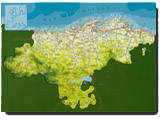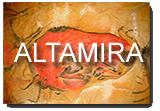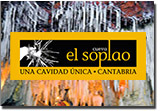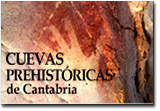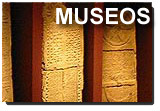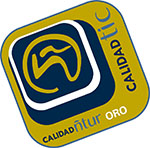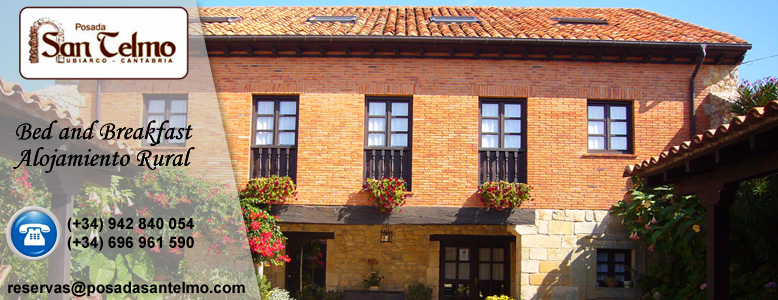
Information  Ubiarco Ubiarco  Ubiarco, where the arch Ubiarco, where the arch
|
| GREEN TOURISM: OLD WAYS AND TRADITIONS |
Green Tourism allows you to enjoy your holidays while keeping in touch with Nature and traditional lifestyles; it also offers a way of using your spare time that is just different. It is, without any doubt, the best way in order to get to know in detail the cultural wealth treasured inside each and every village of the Spanish Autonomous Regions.
Landscapes, flora, fauna, festivals and open-air dances, gastronomy, native sports, customs and traditions, historic architecture... You can find everything inside the wide range of options offered to the visitor and gain a better knowledge of the place you chose to travel to, feeling in the end as the true protagonist of a great adventure.
Hotels in the city leave their place to the so-called Cantabrian Posadas (Inns), Paradores (high class hotels) and Casonas (country manors), all of them typical lodgings from the areas where they are located, restored with care and furnished with every detail in order to turn them into little hotel establishments -and their main characteristics are quiet, comfort, and a nice and family atmosphere.
| WESTERN COAST: THE CLASSICAL ROMANESQUE ROUTE |
Cantabria offers you a variety of touristic routes, among which we must highlight the so-called "Classic Route" or Western Coast Route , coastal strip stretching from Suances to Unquera. This route is our proposal to those wishing to obtain a better knowledge of Cantabria.
The Wester Coast is characterized by the strong relationship between the fishing and cattle-raising traditions. It is the best preserved part of the Cantabrian coast, and inside it we can find such an important natural protected area as the Oyambre Nature Park. Some of the most ancient traditions of our land are well kept in this area -traditions such as the sport of draught oxen and the maritime religious procession of La Fol´┐Ża.
It is a haven for Ecological, Green and Active Tourism, with an important collection of historic and artistic heritage.
| UBIARCO: WHERE THE ARCH |
The village of Ubiarco is just in the middle of the way from Suances to Santillana del Mar -that is, 5 Km. distant from both. Suances and Santillana are small towns where you can find banks, cash dispensers, supermarkets, petrol stations and shops selling the best products of cantabrian craftmanship and gastronomy.
Ubiarco belongs to the Santillana del Mar municipality, and is considered to be one of the oldest inhabited places in the area. The oldest known document refering to it dates from the end of the X century, and thanks to it we are able to know that in the place there was a church consecrated to Saint John. Some years later, at the beginning of the XI century, an inhabitant called Gunderico donates to the Abbot Juan of Santa Juliana a country house he had inherited in the village of Ubiarco.

And, as in all the rest of the villages in the municipality, in the XIV century also here took place the leasing of land by the Colegiata (Collegiate Church) of Santillana del Mar to individuals. So we see that, in 1404, the Chapter grants Fern´┐Żn Gonz´┐Żlez, one of the dwellers of Ubiarco, a land "located in the soil quarry of Ubiarco". In 1409 two pieces of land are granted to Pedro Tordeales, in exchange of him paying tax in wine for one of them and the "diezmo", or religious tax, for the other. And in 1444, Juan Guti´┐Żrrez from Mazcuerras received some land that Guti´┐Żrrez D´┐Żaz from Ubiarco had donated to the Chapter of Santa Juliana in Ubiarco, in exchange of 35 maraved´┐Żes (Spanish currency of the time) every year.
Moreover, we also know that there was a monastery consecrated to Saint Vincent, dependent on the Santillana Abbey, that in 1294 rented some of its lands to Mart´┐Żn Roiz from Ubiarco and his wife Marina, in exchange of two "emias" (old measure) of wheat and a hen.
Back in 1845 Ubiarco belonged to the municipality of Ongayo, and it was described as being located in the middle of a hollow sorrounded by hills, with a population of 36 neighbours (163 inhabitants) -in 1991 the population was of 300 inhabitatns. According to Madoz "the more common illnesses were colds and hysterical troubles". In the middle decades of the XIX century, there were 40 houses, and corn and wheat were cultivated, and there were meadowlands for cattle-raising. Hare, partridge and quail hunting were very common, and also fishing of all sorts down at the sea.
The main architectonic monument in the village is the Parish Church consecrated to Saint John the Baptist, patron of the place, built in the XVII century. Its ground plan has two sections, and a three-floored prismatic tower at its feet. The entrance door is located in the first section of the nave, in the souther fa´┐Żade. There is a square vaulted apse at its back connected to the body of the nave through a round arch made in big masonry stones.
The other interesting building in the village is the Hermitage (Shrine) of Santa Justa, located by the beach bearing the same name, inside the space of a geologichal fault that adds to the charm and beauty of the spot.
| VIDEO Santa Justa Beach in Ubiarco. | |
|
|
|
| VIDEO 360´┐Ż Santa Justa Beach in Ubiarco. | |

The current building might have been built back in the XVI century, moment from which appear many references, both in civil documents (due to its maritime character) and religious ones (due to the pilgrimages to the Hermitage). But the fact is that it doesn´┐Żt show any characteristic of style, being the material used to build it plain masonry and without any decorative element. Only in the door we find a simple round arch, over which there is a little square window that lights the only nave the Hermitage consists of. It is a very interesting building on the grounds of its popular character, its religious attire and its spectacular location.
The photo below shows, is taken in early October, the date on which occur tides and sea water recedes so that you can walk to the chapel by the sand! Spectacular!
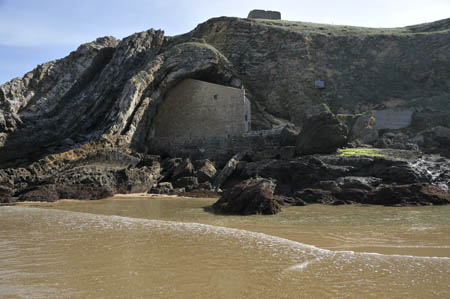
Two other interesting places are the Tower of Saint Telmo and the Inlet of Puerto Calderon (old seaport of Santillana del Mar) -places that offer the traveler incredible general views of the sea and a powerful feeling of peace and harmony.
Rural Lodgings and Green Tourism in Cantabria ´┐Ż Booking online ´┐Ż Spanish Tourism ´┐Ż Bed & Breakfast ´┐Ż Rural Hotels ´┐Ż Santa Justa Beach ´┐Ż Caves of Altamira ´┐Ż Cave of El Soplao ´┐Ż Natural Park of Cab´┐Żrceno ´┐Ż Santillana del Mar ´┐Ż Suances ´┐Ż Comillas ´┐Ż Carmona ´┐Ż Santander ´┐Ż Li´┐Żbana ´┐Ż Picos de Europa . Reserva Natural del Saja . Fontibre . Cantabrian Sea ´┐Ż Mountains ´┐Ż Forests ´┐Ż Cliffs ´┐Ż Nature ´┐Ż History ´┐Ż Art ´┐Ż Culture ´┐Ż Museums ´┐Ż Gastronomy
| POSADA SAN TELMO Barrio Tresvalle 46. 39360, Ubiarco-CANTABRIA (SPAIN). Tel: (+0034) 942 840 054 / (+0034) 696 961 590 |
| the most visited: booking online | services | prices | offers | Cantabria in 7 days PDF | webmap | contact |
| Minimum resolution 800 x 600. Internet Explorer & Firefox © Copyright 1998- LEGAL NOTIFICATION- LSSI |
|








